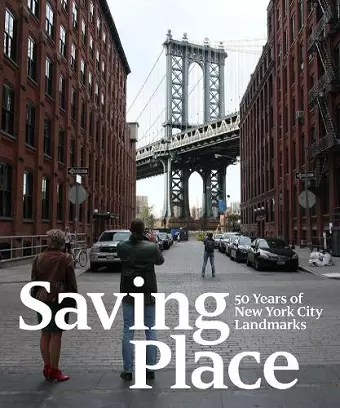Saving Place
50 Years of New York City Landmarks
Donald Albrecht author Iwan Baan illustrator Andrew Dolkart editor Donald Albrecht editor Seri Worden editor
Format:Hardback
Publisher:Monacelli Press
Published:21st Apr '15
Currently unavailable, our supplier has not provided us a restock date

2015 will be the Year of the Landmark- A celebration of the 50th anniversary of the passage of the Landmarks Law, which has shaped the face of New York City today.
From irrefutable icons (Broadway theaters, Central Park, SoHo, Carnegie Hall), to lesser-known structures including the Cyclone rollercoaster on Coney Island, roughly one hundred street lampposts, and seven cast-iron street clocks throughout the city - much of what makes New York City unique owes its existence to the New York City Landmarks Law.
From irrefutable icons (Broadway theaters, Central Park, SoHo, Carnegie Hall), to lesser-known structures including the Cyclone rollercoaster on Coney Island, roughly one hundred street lampposts, and seven cast-iron street clocks throughout the city - much of what makes New York City unique owes its existence to the New York City Landmarks Law.
Born out of the destruction of McKim, Mead & White’s monumental Pennsylvania Station, the Landmarks Law established the parameters for protecting the places that represent New York City’s rich cultural, social, political, and architectural history. Today there are more than 31,000 landmark properties woven into daily life, many located in 111 historic districts in Manhattan, the Bronx, Staten Island, Brooklyn, and Queens - including 1,347 individual buildings, 117 interior landmarks, and 10 scenic landmarks.
Published in celebration of the 50th anniversary of the passage of the Landmarks Law, and a major exhibition at the Museum of the City of New York, Saving Place tells its story in essays by notable New Yorkers and preservationists Robert A.M. Stern, Adele Chatfield-Taylor, Andrew S. Dolkart, Françoise Bollack, Anthony C. Wood, and Claudette Brady: its first successes (the Astor Library, now home to The Public Theater), its failures (the Metropolitan Opera House), and its most dramatic turning points, including the Grand Central Terminal case decided in the U.S. Supreme Court in 1978. It evaluates contemporary additions to landmarks (the Hearst Tower, the Jewish Museum), and new buildings in historic districts including Greenwich Village and South Street Seaport.
The book includes specially commissioned portfolios of views of historic districts and landmark buildings by the distinguished Dutch architectural photographer Iwan Baan. Encompassing all five boroughs, from Bedford-Stuyvesant to Jackson Heights, these images capture the landmarks at work, historic markers that play a vital role in the fabric of their neighborhoods today. What is built, what is demolished, what is preserved - all determine the character and future of the city. A veritable roll call of the places that...
"Filled with Iwan Baan's people-centric photographs of New York City's five boroughs and his famous helicopter aerials, Saving Place, celebrates the 50th anniversary of the New York City Landmarks Law. With archival photographs, too, the book narrates the preservation movement, from its origins to its later successes and failures. A case study dives into the historic-district designature of Bedford-Stuyvesant, a mostly African-American neighborhood in Brooklyn. But given the impact that the law has had on other cities across the country, the entire book serves as a case study. As director of the preservation program at Columbia, Andrew S. Dolkart, and his coeditor Donald Albrecht, a respected design curator, are the ideal team for this project." - Architectural Record
"Despite being in a seemingly constant state of construction, New York City has managed to keep a great deal of its architectural history intact. A quick look at the city’s SoHo area or the centuries-old brownstones that line the streets of quiet Brooklyn neighborhoods reveals there’s much more to the Big Apple than towering skyscrapers and new buildings. This is in large part due to the New York City Landmarks Law put in place on April 19, 1965, after the destruction of one of Manhattan’s most architecturally significant structures - Pennsylvania Station. As local outrage spread over the building’s demise, design lovers and city officials came together to support the law, which would go on to save other gems across the five boroughs. In honor of the anniversary of the legislation, the Museum of the City of New York is celebrating with an exhibition and accompanying book, Saving Place: 50 Years of New York City Landmarks. With essays from prominent New York figures, preservationists, and architects, and imagery by noted architectural photographer Iwan Baan, the book and the exhibition are a testament to the importance of history and the role individuals can play in protecting it." - Architectural Digest
ISBN: 9781580934312
Dimensions: 275mm x 211mm x 27mm
Weight: 1230g
208 pages